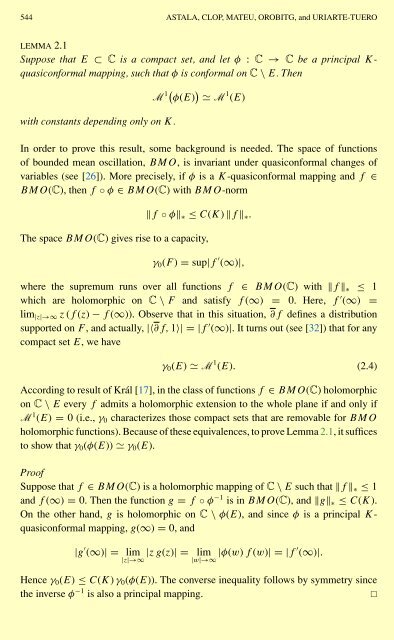A NULLSTELLENSATZ FOR AMOEBAS
A NULLSTELLENSATZ FOR AMOEBAS
A NULLSTELLENSATZ FOR AMOEBAS
You also want an ePaper? Increase the reach of your titles
YUMPU automatically turns print PDFs into web optimized ePapers that Google loves.
544 ASTALA, CLOP, MATEU, OROBITG, and URIARTE-TUERO<br />
LEMMA 2.1<br />
Suppose that E ⊂ C is a compact set, and let φ : C → C be a principal K-<br />
quasiconformal mapping, such that φ is conformal on C \ E. Then<br />
with constants depending only on K.<br />
M 1( φ(E) ) ≃ M 1 (E)<br />
In order to prove this result, some background is needed. The space of functions<br />
of bounded mean oscillation, BMO, is invariant under quasiconformal changes of<br />
variables (see [26]). More precisely, if φ is a K-quasiconformal mapping and f ∈<br />
BMO(C), thenf ◦ φ ∈ BMO(C) with BMO-norm<br />
‖f ◦ φ‖ ∗ ≤ C(K) ‖f ‖ ∗ .<br />
The space BMO(C) gives rise to a capacity,<br />
γ 0 (F ) = sup|f ′ (∞)|,<br />
where the supremum runs over all functions f ∈ BMO(C) with ‖f ‖ ∗ ≤ 1<br />
which are holomorphic on C \ F and satisfy f (∞) = 0. Here, f ′ (∞) =<br />
lim |z|→∞ z (f (z) − f (∞)). Observe that in this situation, ∂f defines a distribution<br />
supported on F , and actually, |〈∂f,1〉| = |f ′ (∞)|. It turns out (see [32]) that for any<br />
compact set E, wehave<br />
γ 0 (E) ≃ M 1 (E). (2.4)<br />
According to result of Král [17], in the class of functions f ∈ BMO(C) holomorphic<br />
on C \ E every f admits a holomorphic extension to the whole plane if and only if<br />
M 1 (E) = 0 (i.e., γ 0 characterizes those compact sets that are removable for BMO<br />
holomorphic functions). Because of these equivalences, to prove Lemma 2.1, it suffices<br />
to show that γ 0 (φ(E)) ≃ γ 0 (E).<br />
Proof<br />
Suppose that f ∈ BMO(C) is a holomorphic mapping of C \ E such that ‖f ‖ ∗ ≤ 1<br />
and f (∞) = 0. Then the function g = f ◦ φ −1 is in BMO(C), and‖g‖ ∗ ≤ C(K).<br />
On the other hand, g is holomorphic on C \ φ(E), and since φ is a principal K-<br />
quasiconformal mapping, g(∞) = 0,and<br />
|g ′ (∞)| = lim |zg(z)| = lim |φ(w) f (w)| =|f ′ (∞)|.<br />
|z|→∞ |w|→∞<br />
Hence γ 0 (E) ≤ C(K) γ 0 (φ(E)). The converse inequality follows by symmetry since<br />
the inverse φ −1 is also a principal mapping.
















